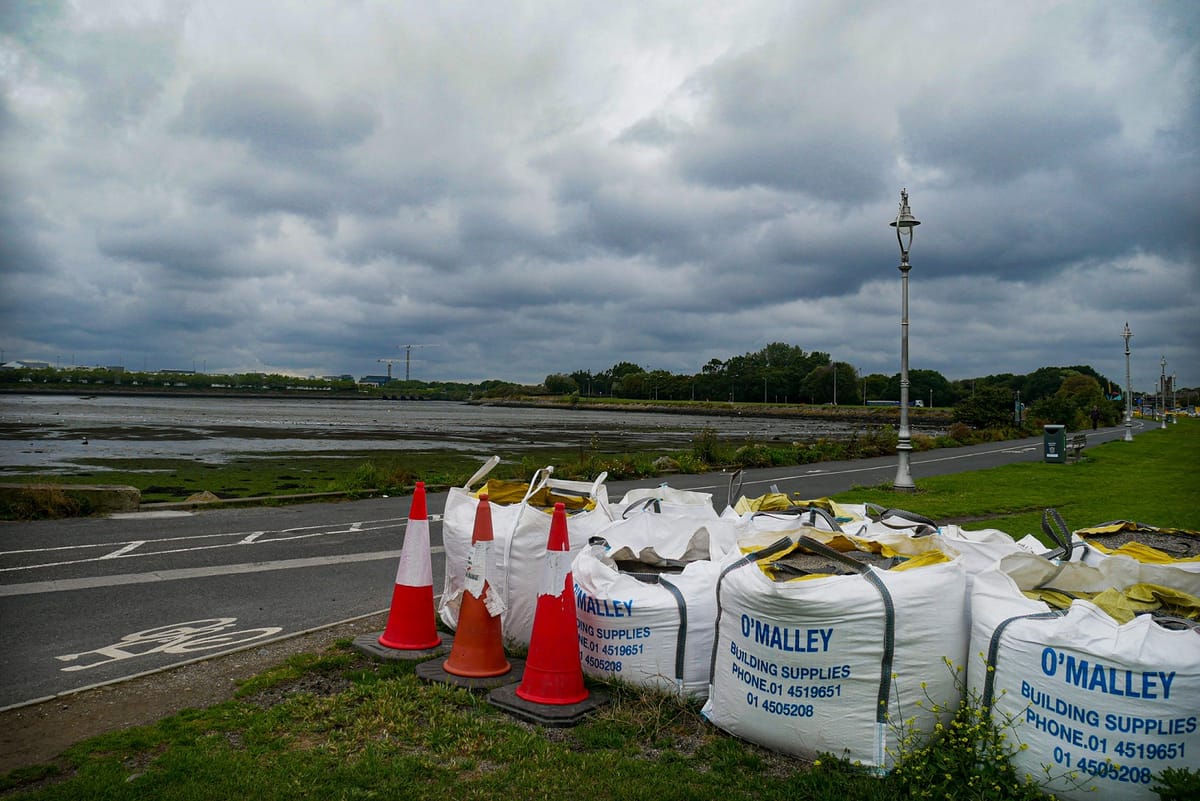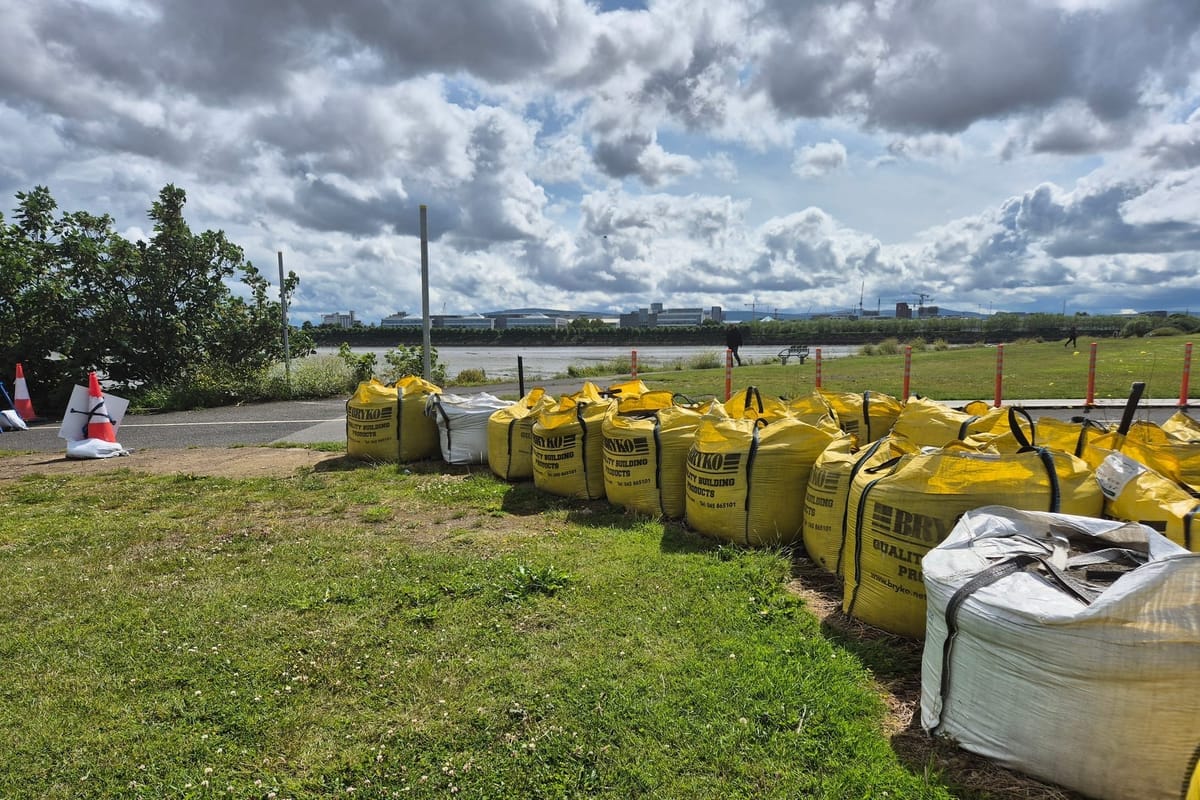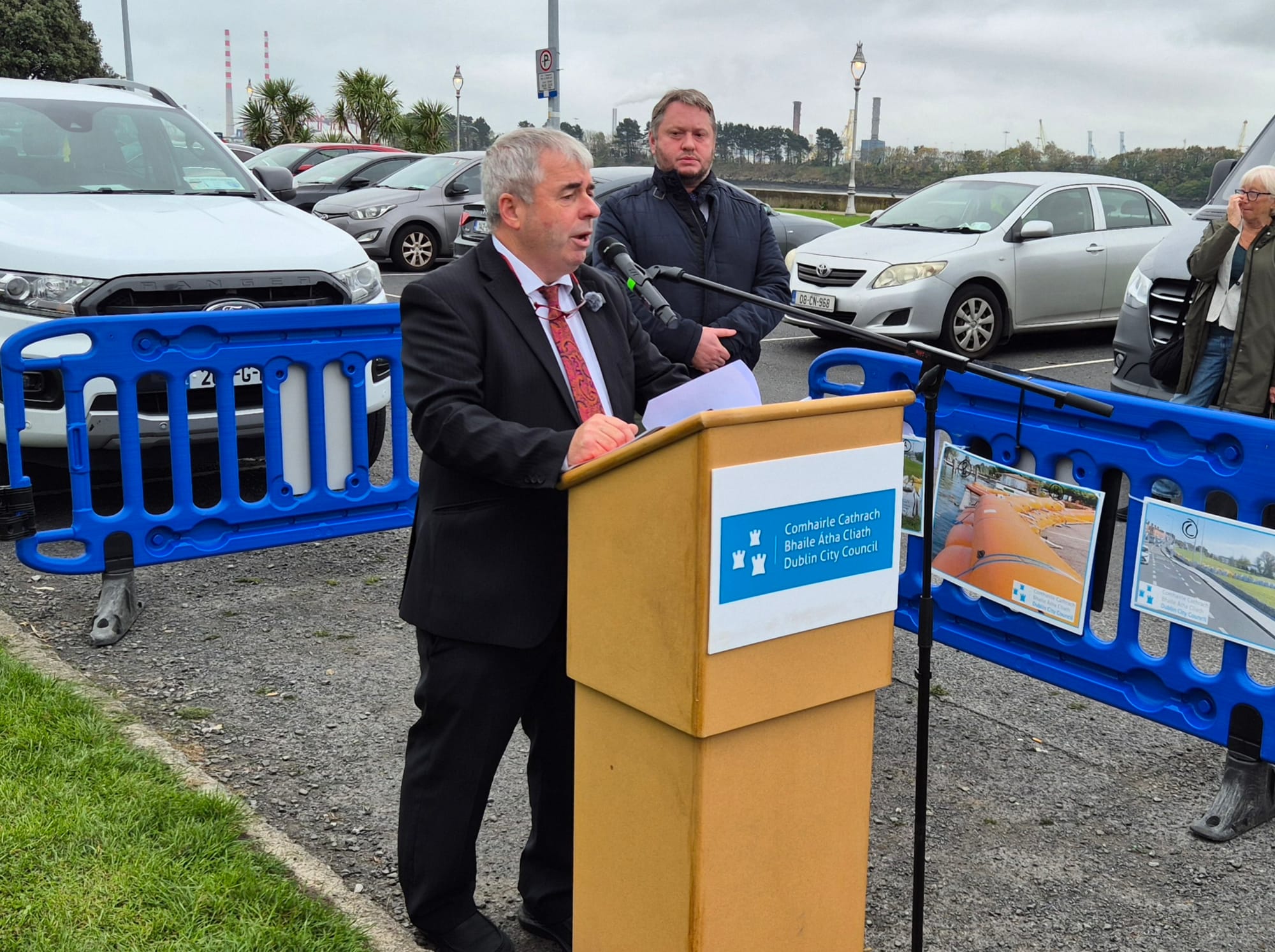In Ballymun, lining up to read and reconnect with the constitution
“Some people have said it's a bit like karaoke.”
“We’ve kind of a repurposed Berlin Wall here,” said Pat Walsh, secretary of the Clontarf Business Association, about the recommended measure.

For over a decade, local representatives, residents and business owners in Clontarf have been asking for flood-defence measures to replace a row of big yellow and white sandbags installed “temporarily” along the promenade.
In May, Kevin “Boxer” Moran TD, the minister of state for the Office of Public Works (OPW), and others, visited the sandbags, and pledged to replace them with a different alternative temporary flood-defence.
Tuesday morning, everyone got their first glimpse of what the new temporary measures could look like, while the wait for a permanent solution continues.
A presentation was held on the Clontarf Road, opposite St Anthony’s Church, by officials from Dublin City Council and the Office of Public Works (OPW), and Moran.
There were, in fact, 12 potential temporary measures on display, with one option in particular recommended over others by officials.
“This is an interim solution,” said Andy Walsh, executive manager for engineering of the council’s Environmental Protection Division. “It'll never be as brilliant as the permanent solution.”
Rather than gaudy sandbags, Clontarf will likely get a low brutalist modular cement wall, made of what are known elsewhere as Jersey barriers, often used to separate lanes of traffic temporarily.
Moran acknowledged the frustration and anger among locals in the delays in progress up to this point – but he said progress was being made, and that locals should be happy about that.
Having travelled the length and breadth of the country, Moran said he’d met people in a number of communities who “would love to be in the position that you find yourselves in today”.
Meanwhile, Dublin City Council is still slowly working its way through the process of deciding on a design for a permanent solution, having hit delay after delay over the years, unable to agree the detail with local residents.
As the years have passed, and the sea level has swelled, the risks of coastal flooding in Clontarf have grown.
Severe tidal flooding in February 2002 triggered plans for a flood-defence scheme in coastal Clontarf.
Councillors voted against plans in 2011 to build a 3km long, 1.5m- to 2.5m-high mound and wall along the Clontarf seafront, after thousands protested.
Council officials and community representatives formed a joint working group in 2013 to have another go at coming up with a better idea and approach for the flood defences. They didn’t manage to agree, though.

As all this rumbled on, the council plopped the sandbags down on the promenade, and has defended them against criticism since then.
“The sandbags … must remain in place until more substantial permanent tidal flood barriers can be installed,” the council’s chief executive, Richard Shakespeare, wrote last November.

But after Moran visited the Clontarf sandbags in May, along with independent local TD Barry Heneghan and independent local councillor Kevin Breen, Dublin City Council agreed to recommend alternatives.
Each of the 12 potential replacements put forward was assessed based on factors including how well it would defend against flooding, how durable it would be, and how much maintenance it would require, the explanatory document says.
As well as whether it would require planning permission, how hard it would be to install, how it would look, and how much it would cost, the document says.
The council and the OPW then gave each of the options a score based on these factors.
An earth embankment – semi-temporary bunds made of compacted soil or fill – scored well for performance, durability and aesthetic quality, according to the document.
But it was flagged as being unfeasible due to planning requirements, says the document.
A solution from the company Hesco called a Floodline – large connected units resembling sandbags within reinforced cages – was rated okay in some categories, but scored zero on aesthetic quality.
A NOAQ Box Wall Barrier also didn’t make the cut, despite scoring high on ease of deployment, and for not requiring any planning permission. It scored zeros on both protection performance and durability.
Based on the ratings, the OPW and council officials recommended one measure above the rest – the precast concrete interlocking barrier, on the roadside.
Failing that, the next best thing, according to officials, is a precast concrete interlocking barrier positioned along the waterside.
An example of this new barrier was on display yesterday in Clontarf, and graphics of the other options were there to look at too.
The barrier is made of pre-fabricated interlocking concrete units, 850 mm tall – a similar height to the existing sandbags, Green Party Councillor Donna Cooney said.
There are pedestrian/bicycle openings at intervals, which council workers would have to plug up quickly, ahead of potential flood events, said Andy Walsh.
Positioning the barrier on the roadside, as opposed to by the water, means the grass stretching from there towards the water – and the cycleway through it – might be covered in water during flooding, according to the document.
While machinery would be needed to install the barriers, that installation is once-off and maintenance costs are minimal, the explanatory document says.
There is an estimated cost of €100,000 for the waterside option, which rises to €120,000 for the roadside option. The roadside version would require an additional 50 metres in length.
“We’ve kind of a repurposed Berlin Wall here,” said Pat Walsh, secretary of the Clontarf Business Association, about the recommended measure.
At yesterday's event, Walsh raised concerns about the carbon impact of pre-fabricated concrete.
Most European countries are moving away from this material for flood defence, he said. “I’m a bit disappointed if that’s the best option you’re presenting.”
While the blocks currently on display on the Clontarf seafront are grey concrete, they could be decorated with murals, plantings, hedging or seating, officials say.
Independent Councillor Kevin Breen suggested a mural commemorating 1014’s Battle of Clontarf.

At the event today, Cooney, the Green Party councillor, said she was frustrated that local representatives like her were not offered a chance to give their input on the options, before the public exhibition.
“This is the first we’re seeing of it,” Cooney said.
Walsh, secretary of the Clontarf Business Association, was also concerned about the lack of involvement for those with long-term interest in the very long-running Clontarf flood-defence saga.
“It’s just another sign of the extremely poor treatment of the local councillors, and the community, and the businesses that, once again, we’re being treated with contempt,” Walsh said. “With only a few days’ notice, given these options and expected to come back within one week.”
After an 11-year wait, Walsh says, stakeholders need a more reasonable amount of time to consider it.
“I appreciate your … maybe some of your points there,” said Andy Walsh, of Dublin City Council. The reason for the lack of prior consultation was urgency, he said.
However, stakeholders are welcome to take more time – two or three weeks – to mull the proposals over, if needed, he said.
Since the sandbags were originally left along the coast, Pat Walsh says he estimates that businesses around the immediate area have paid over €3 million in commercial rates. “With not one rebate for the disgusting premise in front of them.”
Deirdre Nichol, chairperson of the Clontarf Residents Association, asked for a commitment from the council that the new concrete barriers would only be installed to replace the current sandbags.
And not installed in other places along the seafront in Clontarf, without consultation with local stakeholders, Nichol said.
Andy Walsh, the council manager, assured her that there was no question of extending them beyond the area currently occupied by sandbags.
The preliminary design for a permanent flood-defence along the Clontarf seafront is currently being wrapped up, says Andy Walsh. There'll be consultants appointed early in the new year, he said.
Councillor Deirdre Heney of Fianna Fáil asked officials if there is any concern that the focus on temporary measures would delay the plans for a permanent solution.
No, said Andy Walsh. “It's a parallel process that's continuing absolutely independently of this.”
What is the expected timeframe for this permanent scheme? asked Fine Gael Councillor Clodagh Ní Mhuirí.
All going well, accounting for planning processes and objections, delivery is four or five years away, Andy Walsh said.
Funded by the Local Democracy Reporting Scheme.